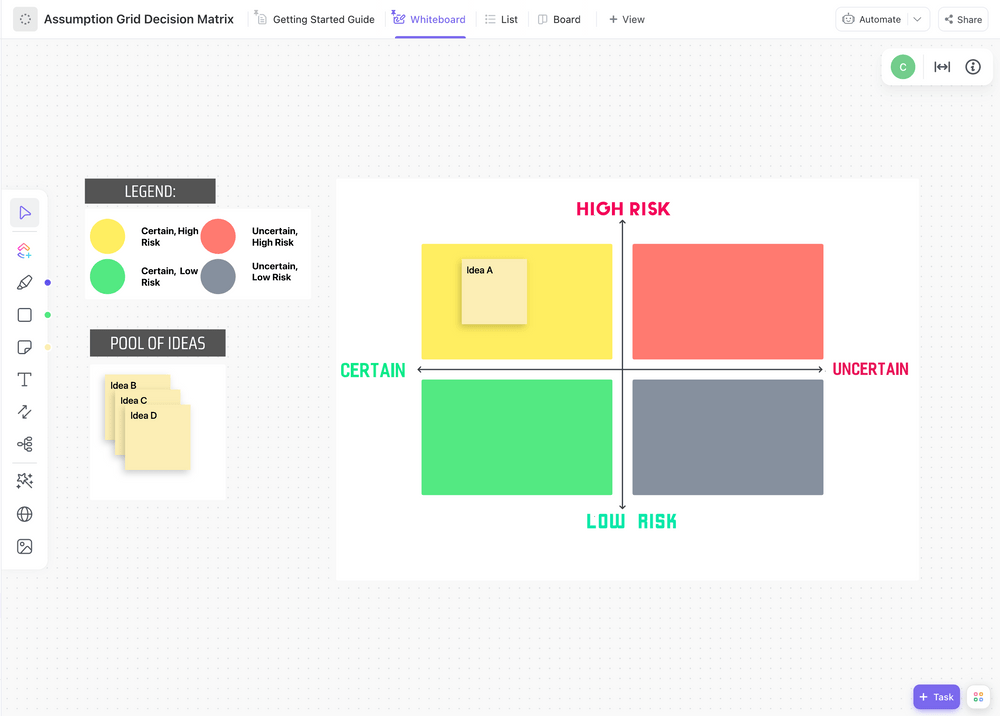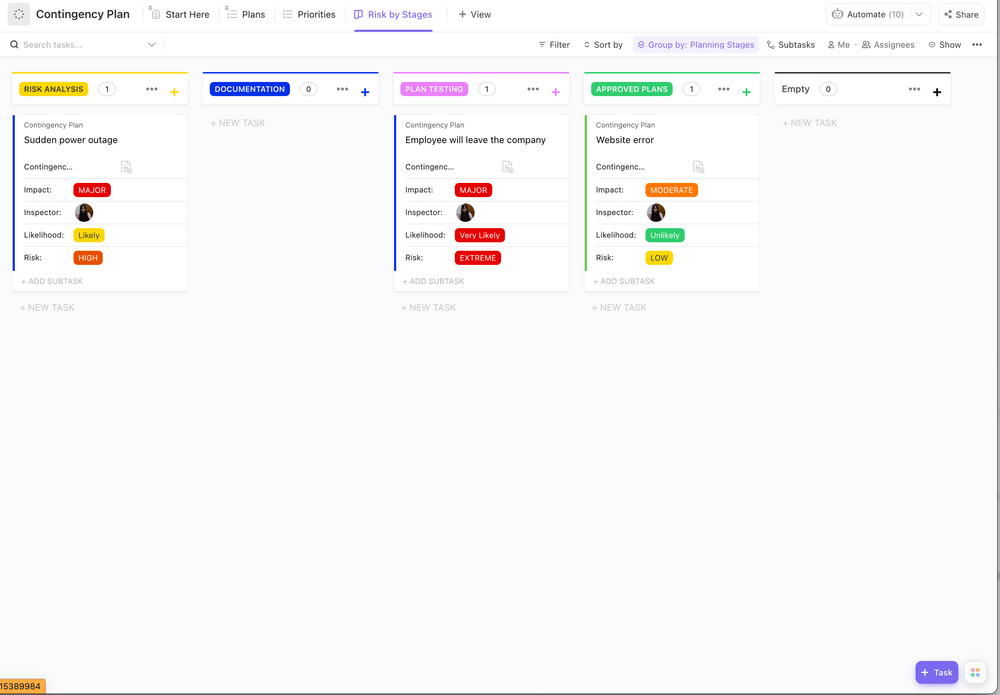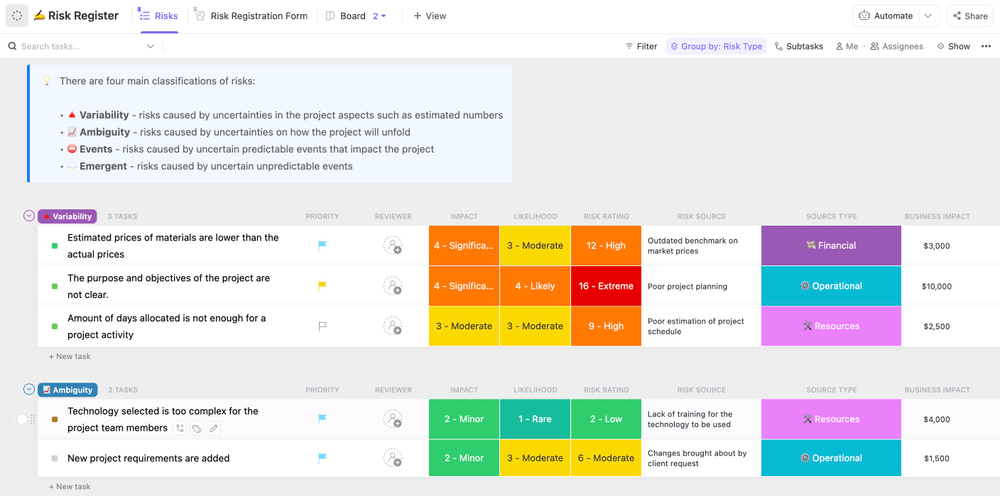

We make assumptions every time we estimate deliverables, timelines, and resource requirements for a new project.
While historical data and analytics can aid our decision-making, not everything goes as planned. Therefore, some risk assessments and educated guesses are necessary at the beginning of the project.
This is where the feasibility assumptions and detailed assumptions within the mapping framework come in.
They help you analyze data-driven information to uncover hidden risks and logically make assumptions. This critical step helps us in multiple ways, including:
- Risk mitigation: Identifies potential weaknesses before they escalate into costly problems
- Enhanced communication: Allows business stakeholders and cross-functional team members to be on the same page, by openly acknowledging and discussing assumptions
- Clear decision-making: Brings clarity and builds a shared understanding of the underlying beliefs guiding the project toward its defined outcome
Read on as we explore how assumptions can be part of our decision-making and how you can use assumption mapping to test new product ideas and business strategies.
- Understanding the Concept of Assumptions Mapping
- How do you get started with the assumptions mapping process?
- How to Test Assumptions
- How to Conduct Assumptions Mapping Workshop
- Significance of Assumptions Mapping in Product Development
- Tools to Implement Assumptions Mapping and Mitigate Risk
- Build a Resilient Project Management Strategy Using ClickUp
Understanding the Concept of Assumptions Mapping
Assumption mapping is a framework that helps you identify and understand risky assumptions that you may have made about your business or product. This process can help you:
- Assess the potential impact of your assumptions on the decision-making process
- Identify any biases or gaps in thinking
- Develop more effective strategies to address immediate blockers or prepare for future risks
To do this, each assumption is categorized into three key categories:
1. Desirability assumptions
Desirability assumptions focus on the needs and desires of your target audience. This includes answers to questions like:
- How appealing is your solution or service to the target audience?
- Will they enjoy using it?
- Do they need the product you are building?
- Is there any marketing research or competitive analysis that can help you support their desire?
Understanding and meeting your customers’ desires is not just important; it’s crucial for ensuring the ideal product-market fit.

2. Feasibility assumptions
Feasibility assumptions focus on whether an idea you envision can come to reality. It answers questions like:
- Is the product being developed feasible based on the existing frameworks and technology?
- Does your team have the necessary skills or technology expertise to build and maintain this product?
- Are there any legal or industry concerns that can derail this project, now or in the future?
This thinking process can help you assess the technical capabilities, resource constraints, and other factors that could impact your project or idea.
3. Viability assumptions
Even if your product or service is desirable and feasible, does it have a sustainable business model? Viability assumptions focus on this in detail, understanding your product’s market potential, pricing strategy, and long-term profitability.
It helps you find answers to questions like:
- Are customers willing to pay for the product or service you are working on?
- How will it contribute to your business’s success?
- Will it help you generate profitability to justify the work being done?
No matter how desirable or feasible your product is, you may not have a strong business model if it is not viable.
Assumption mapping framework across industries
The beauty of assumption mapping lies in its versatility. This framework can be used for various industries and organizations, such as:
- E-commerce: Assumption mapping can be used to make decisions around customer buying behavior, product demand, and logistics efficiency
- Marketing: Map assumptions to help define target customers’ preferences, usability tests, campaign effectiveness, and brand perception
- Remote Work: Assumption mapping can be used to understand if remote work is feasible for a company compared to traditional or hybrid working. You can use data around productivity levels, collaboration, and employee preferences to understand which model works best
- Startups: Test assumptions about product-market fit, feasibility hypotheses, product development process, funding feasibility, and go-to-market strategies
- Education: Explore assumptions about learning styles, curriculum effectiveness, and student engagement with online platforms
How do you get started with the assumptions mapping process?
Now you know how desirability, viability, and feasibility assumptions work and where to use them. But how do you implement the assumption mapping process in your business model? We have outlined a step-by-step process for you:
Step 1: Identify the hypothesis
Before any assumption mapping exercise, clearly define the overall goal or question you’re trying to answer with your project or product.
For example, your hypothesis could be: “Our target audience will pay a premium price for a subscription-based fitness app with personalized workout routines.” Based on your objective, you will need to define testing assumptions and gather other information to help you with the next step.
Step 2: Brainstorm assumptions
Next, gather your team and start putting together a list of all the unknown events that can impact your project or business idea! Brainstorm all the underlying assumptions that support your hypothesis.
Remember to consider desirability, feasibility, and viability throughout this process. Here are some prompts to get you going:
- Desirability: Will users find our product valuable and solve a real problem for them? Are they willing to pay for it?
- Feasibility: Can we technically build what we envision? Do we have the necessary resources and expertise?
- Viability: Is there a sustainable market for our product or service? Can we generate enough revenue to be profitable?

Step 3: Prioritize and map your assumptions
Not all assumptions are created equal. Use a prioritization matrix or project assessment templates to evaluate each assumption based on its importance (how critical it is to your project’s success) and confidence (how certain you are that the assumption is true).
To prioritize your assumptions, use the ClickUp Assumption Grid Decision Matrix to help you start instantly. This ready-to-use template lets you use an assumption grid for effective decision-making, allowing you to make decisions like:
- Evaluating all the factors for your project
- Identifying and prioritizing critical decisions
- Making informed decisions about your assumptions
- Understanding potential risks and rewards based on your decision
How to Test Assumptions
Once you’ve identified and prioritized your risky assumptions, it’s time to put them to the test! Here are five approaches that you can use to validate your assumptions and gather valuable insights:
1. User interviews
You can directly gather feedback from your end users or potential target audience to help validate your project assumptions. Conduct in-depth conversations to understand user needs, pain points, and interest in your product concept.
By asking targeted questions that directly address your assumptions about user behavior and their perception of value (Desirability), you can understand if your product or idea is ideal for the target group.
2. Market research
Leverages existing data to understand market trends, competitor landscapes, and potential customer demographics. This helps us validate assumptions about viability (market size, competition) and desirability (understanding broader user needs within your target market).
3. Usability testing
While not directly related to Assumption Mapping, usability testing becomes relevant after initial validation. Once you have a basic prototype, usability testing examples with real users help identify usability issues that might hinder user experience (Desirability).
4. Technical testing
Similar to usability testing, technical testing focuses on functionality rather than assumptions. It ensures your product functions as intended and identifies any technical limitations or bugs that might impact feasibility.
5. Competitive analysis
Analyzing competitors’ products, marketing strategies, and user reviews can help you gain insights into the viability and desirability of your product or business idea.
You can use these competitive analysis templates to validate assumptions about the competitive landscape (Viability) and inform your product map with features or functionalities users find desirable (Desirability).
Use ClickUp Docs to document your research findings and hypotheses in a collaborative, easy-to-share format.

How to Conduct Assumptions Mapping Workshop
By involving a diverse group in the mapping exercise, you can conduct a more well-rounded and thorough analysis, ensuring a 360-degree approach. Effective collaboration is necessary at this stage, allowing you to draw out unique perspectives and insights from your stakeholders.
To make this happen, you need to:
1. Define the scope and goals
Establish the specific goals you aim to achieve through assumption mapping.
Do you want to:
- Identify key risks?
- Validate core user needs?
- Test out an alternative approach to product development?
Ensure everyone is on the same page about the topic and keep your discussions structured to achieve the desired outcome.
2. Invite the right people
Assemble a cross-functional team with different perspectives and expertise relevant to the project. This could include project managers, product managers, designers, developers, and potential customers (if feasible).
3. Facilitate brainstorming
Choose a collaborative space with enough room for brainstorming and discussion. Guide the team through a brainstorming session to identify all the underlying assumptions related to the project goals.
Encourage active participation and challenging perspectives. This will reveal many assumptions and insights that might not surface otherwise.
Techniques like six thinking hats can help uncover targeted insights about a specific concern.
For this process, you can use whiteboards, sticky notes, markers, or the ClickUp Risk Assessment Whiteboard Template. This fully customizable template is ideal for beginners and comes with a detailed framework to help you accurately assess the potential risks associated with your project.
This will help you to:
- Evaluate risk categories and impacts
- Analyze risk data and analyze potential areas of concern
- Take preventive measures to mitigate these risks proactively
4. Define priorities
Once all assumptions are captured, use a prioritization matrix to evaluate each assumption based on its importance and level of confidence. Focus on high-importance, low-confidence assumptions for further discussion and testing.
You can use risk management software or tools like ClickUp’s Contingency Plan Template to address the key issues highlighted in your assumption mapping. This planning will help you to:
- Develop a customized plan that addresses potential risks and scenarios
- Provide all members with a clear understanding of their roles and responsibilities
- Anticipate and respond to known and unknown events effectively
- Reduce the impact of these disruptions on your overall operations
Significance of Assumptions Mapping in Product Development
Assumption mapping isn’t just a one-time brainstorming exercise. It serves as a powerful tool throughout the product development lifecycle. It helps you with multiple product development activities, such as:
1. Product discovery
Assumption Mapping is a proactive approach that helps you pinpoint assumptions about user behavior, pain points, and desired features. By testing these assumptions early, you can steer clear of expensive development errors and ensure your product resonates with your intended audience.
2. Competitive analysis
Assumptions often stem from your understanding of the competitive landscape. Assumption Mapping forces you to articulate these assumptions about your competitors’ strengths, weaknesses, and target audience. Testing and validating these assumptions head-on will help you gain insights into your competitive advantage and identify potential gaps in the market.
3. Resource allocation
Assumption Mapping allows you to prioritize your assumptions based on their potential impact on project success. By first testing high-importance assumptions, you can allocate resources efficiently and avoid wasting time and effort on assumptions with lower impact.
Tools to Implement Assumptions Mapping and Mitigate Risk
We have seen multiple techniques to help make well-thought-out assumptions and manage risks for your important projects.
However, to manage and identify risks, you need a clear visualization of your operations, with detailed inputs into the activities, deadlines, task owners, and requirements.
By staying informed and prepared, you can proactively identify and take action on impending risks and reduce the chances of any instance derailing your dream project.

That’s why a top-rated project and risk management tool like ClickUp has to be part of your risk detection and management process.
The tool comes with several features that allow you to perform multiple assumption mapping and risk assessment processes, including:
- Getting end-to-end insights into your entire project’s performance, team activities, resource allocation, and more using ClickUp Dashboards. This provides you with a flexible canvas of data, transforming your notes or assumption details into visual graphs, charts, cards, lists, and other forms tailored to your needs
- Track time for your entire project and resources, helping you set estimates and make proactive decisions on your upcoming timelines and tasks. With ClickUp Project Time Tracking, you can measure team productivity, track time taken for even the smallest activities, and gain insights into how your team is performing
- Store all your workshop findings, testing results, and ongoing discussions in centralized ClickUp Docs. This fosters transparency and ensures everyone stays aligned
- Set up automated workflows to trigger actions based on specific events using ClickUp Automations
- Automate tasks and use the power of AI to brainstorm, write content, and summarize tests using ClickUp Brain

Mitigate risks faster with ClickUp’s ready-to-use templates
With ClickUp’s advanced risk assessment templates, you can bring much-needed clarity and structure to the assumption mapping process. We’re sharing two key risk-assessment templates here for you:
1. ClickUp Risk Register Template
By incorporating ClickUp into your assumption mapping process, you can transform the way you identify and mitigate risks, setting your project or product up for success. For instance, with ClickUp Risk Register Template, you can track and manage the potential risks for your entire organization with advanced features to help you:
- Provide a standardized system for risk tracking and evaluation
- Improve team communication between various stakeholders and departments
- Identify risks and plan mitigation strategies
- Increase the accuracy and efficiency of your entire risk management process
2. ClickUp Project Management Risk Analysis Template
The ClickUp Project Management Risk Analysis Template is a great option for analyzing project risks and taking appropriate mitigation actions. It also comes with ready-to-use elements and frameworks to help you:
- Identify potential risks for your project
- Analyze the likelihood of these risks and assumptions having an impact on your project
- Create mitigation plans to avoid these risks and assumptions in the future
Build a Resilient Project Management Strategy Using ClickUp
Assumption mapping is a powerful process for project managers, product managers, business analysts, and startup founders. It helps make data-driven decisions and navigate uncertainty confidently.
By identifying and testing assumptions, you can reduce risk, improve communication, and build successful products that meet the needs of your target market.
ClickUp can be your one-stop shop for managing every stage of the process mapping. From brainstorming and prioritizing to testing, documentation, and communication, ClickUp’s advanced risk identification features can help you streamline your workflow and empower your team to mitigate risks early in the process.
So, don’t let assumptions derail your well-planned projects. Embrace the power of the assumptions mapping framework to help you make decisions with clarity and ultimately achieve your business goals. With ClickUp, achieving this is easier.
Sign up for a free ClickUp account today and build a more resilient and successful project management strategy!








